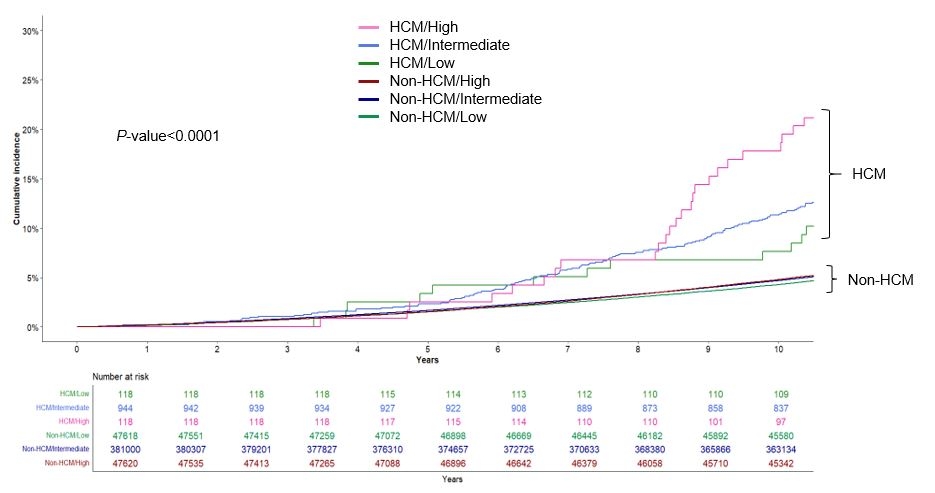Final ID: TMP101
Clinical and Genetic Risk Factors Predict Atrial Fibrillation Based on Hypertrophic Cardiomyopathy
Abstract Body: Background: Clinical and genetic predispositions are significant in predicting atrial fibrillation (AF); however, their role in patients with hypertrophic cardiomyopathy (HCM) remains unclear. This study aims to elucidate the impact of clinical and genetic risk factors on the development of AF in patients with and without HCM.
Methods: This retrospective analysis involved data from the UK Biobank cohort, collected between 2006 and 2010. The cohort comprised 500,543 individuals: 1,361 diagnosed with and 499,182 without HCM. Participants were stratified based on their validated polygenic risk score for AF: the bottom 10% constituted the low-risk genetic group, the top 10% comprised the high-risk genetic group, and the remainder comprised the intermediate-risk genetic group. We assessed the incidence of AF and cardiovascular complications and analyzed its predictors, including genetic risk.
Results: We examined 1,180 patients with HCM (mean age 61.1±7.1, 63.0% male) and 476,238 participants without HCM (mean age 57.0±8.1, 45.3% male). During the 11.6-year follow-up period, the age- and sex-adjusted AF incidence rates for the low-, intermediate-, and high-risk genetic groups were 2.4, 3.6, and 5.4 per 100 person-years in patients with HCM and 0.2, 0.5, and 1.0 per 100 person-years in participants without HCM, respectively. Genetic risk was a less significant predictor of AF in HCM groups (HR:2.51, 95%CI:1.59–3.98) than in non-HCM groups (HR:4.77, 95%CI:4.47–5.09) (P=0.008 for interaction). Clinical risk factors, including male sex, body mass index, hypertension, and previous myocardial infarction, were less significant predictors of AF in patients with HCM than in those without HCM. A high genetic risk was significantly associated with the risk of cardiovascular complications in participants with and without HCM.
Conclusions: Genetic predisposition was associated with the development of AF and cardiovascular complications in people with and without HCM; this association was weaker in the HCM group.
Methods: This retrospective analysis involved data from the UK Biobank cohort, collected between 2006 and 2010. The cohort comprised 500,543 individuals: 1,361 diagnosed with and 499,182 without HCM. Participants were stratified based on their validated polygenic risk score for AF: the bottom 10% constituted the low-risk genetic group, the top 10% comprised the high-risk genetic group, and the remainder comprised the intermediate-risk genetic group. We assessed the incidence of AF and cardiovascular complications and analyzed its predictors, including genetic risk.
Results: We examined 1,180 patients with HCM (mean age 61.1±7.1, 63.0% male) and 476,238 participants without HCM (mean age 57.0±8.1, 45.3% male). During the 11.6-year follow-up period, the age- and sex-adjusted AF incidence rates for the low-, intermediate-, and high-risk genetic groups were 2.4, 3.6, and 5.4 per 100 person-years in patients with HCM and 0.2, 0.5, and 1.0 per 100 person-years in participants without HCM, respectively. Genetic risk was a less significant predictor of AF in HCM groups (HR:2.51, 95%CI:1.59–3.98) than in non-HCM groups (HR:4.77, 95%CI:4.47–5.09) (P=0.008 for interaction). Clinical risk factors, including male sex, body mass index, hypertension, and previous myocardial infarction, were less significant predictors of AF in patients with HCM than in those without HCM. A high genetic risk was significantly associated with the risk of cardiovascular complications in participants with and without HCM.
Conclusions: Genetic predisposition was associated with the development of AF and cardiovascular complications in people with and without HCM; this association was weaker in the HCM group.
More abstracts on this topic:
A Curious Complete Heart Block with Carfilzomib
Shah Mohammed, Rahman Naveed, Al-mohamad Talal, Batra Sejal, Vyas Apurva
A Bifunctional Actuator Reverses NaV1.5 Dysfunction Linked To Cardiac ArrhythmiasFossier Lucile, Yehya Marc, Mahling Ryan, Gabelli Sandra, Colecraft Henry, Ben Johny Manu
Readers' Comments
We encourage you to enter the discussion by posting your comments and questions below.
Presenters will be notified of your post so that they can respond as appropriate.
This discussion platform is provided to foster engagement, and simulate conversation and knowledge sharing.
You have to be authorized to post a comment. Please, Login or Signup.
Rate this abstract
(Maximum characters: 500)

